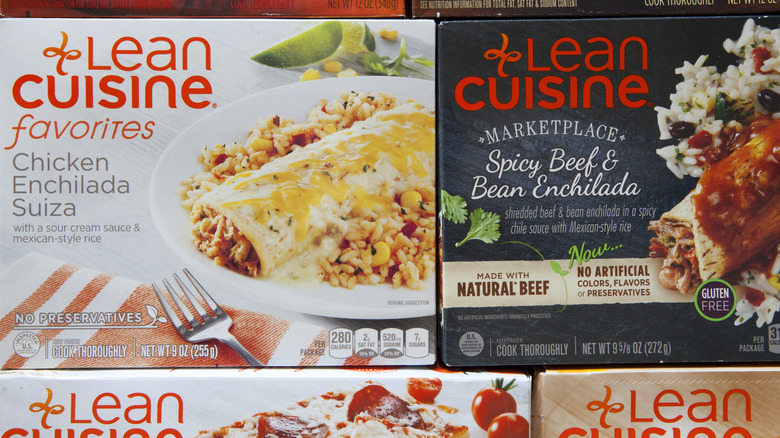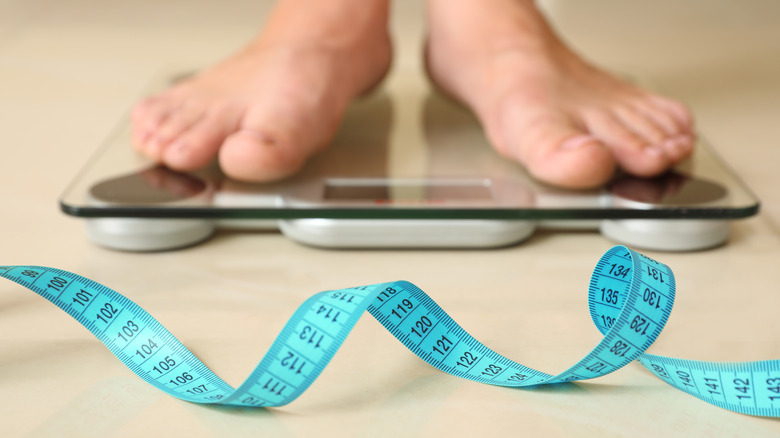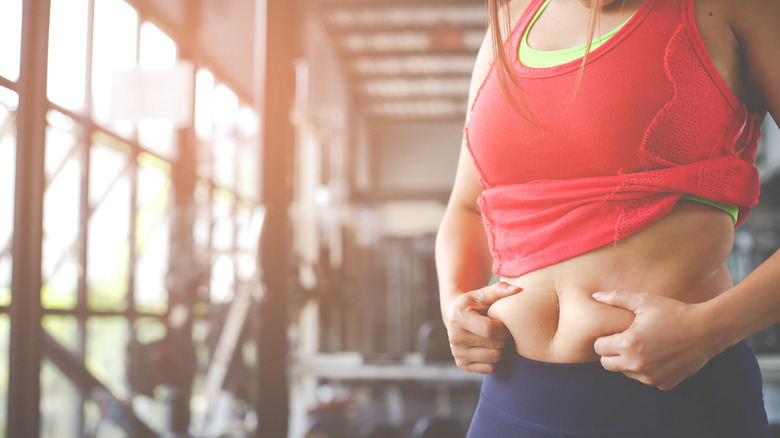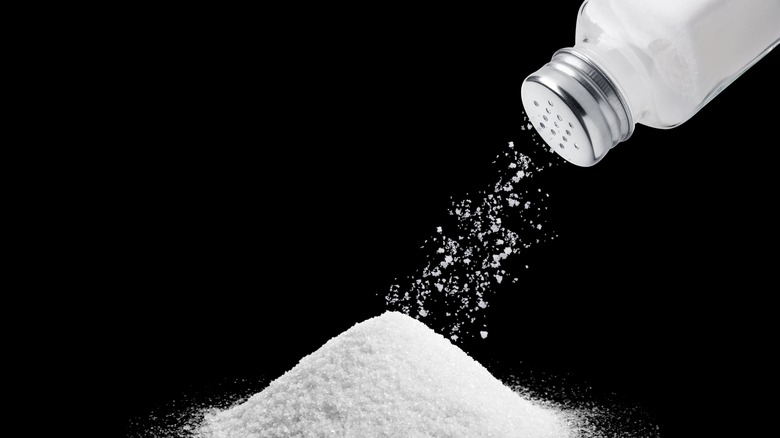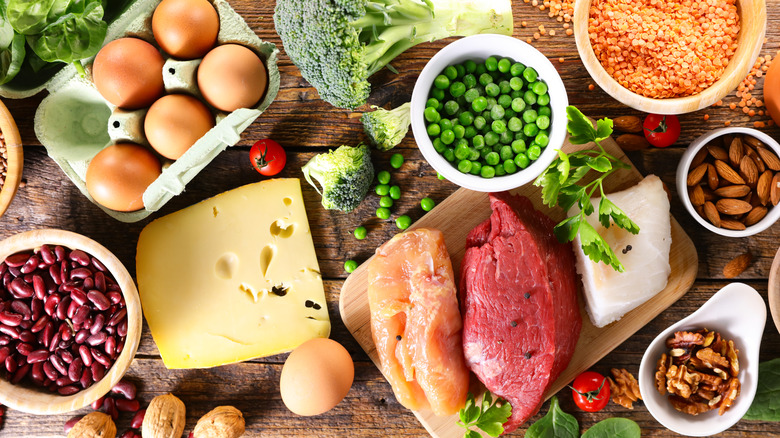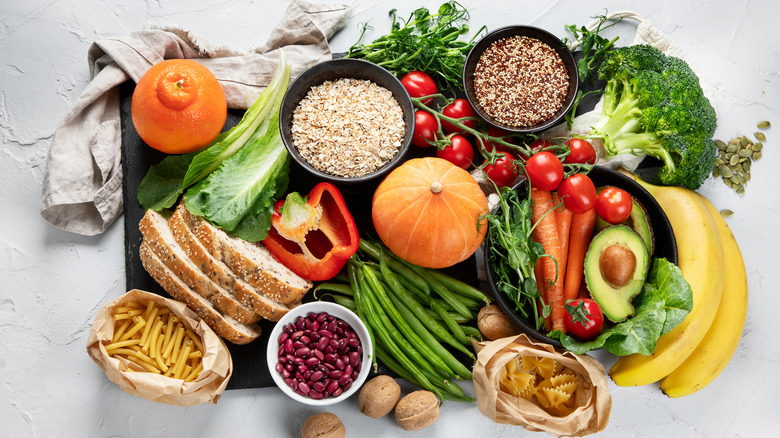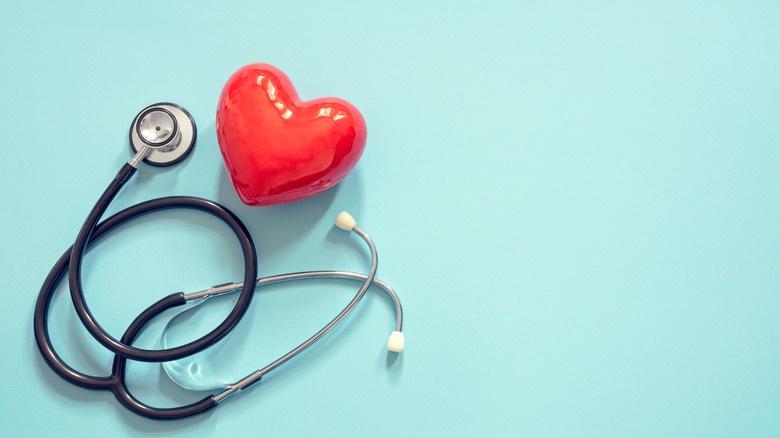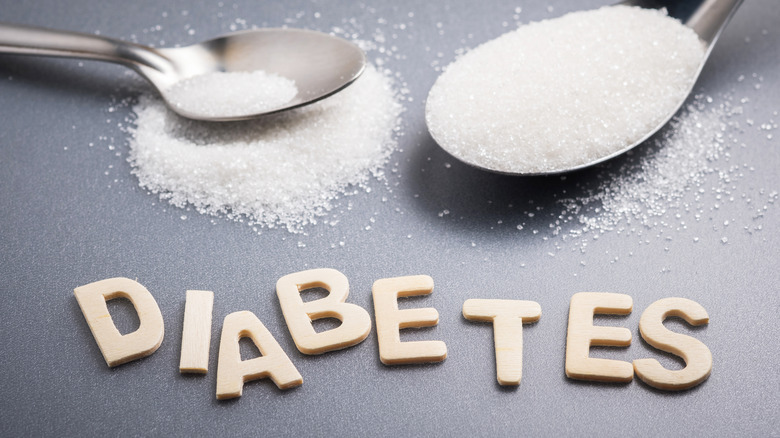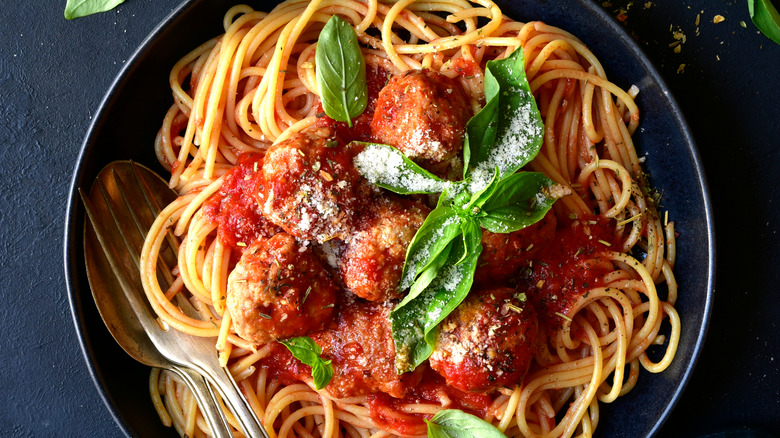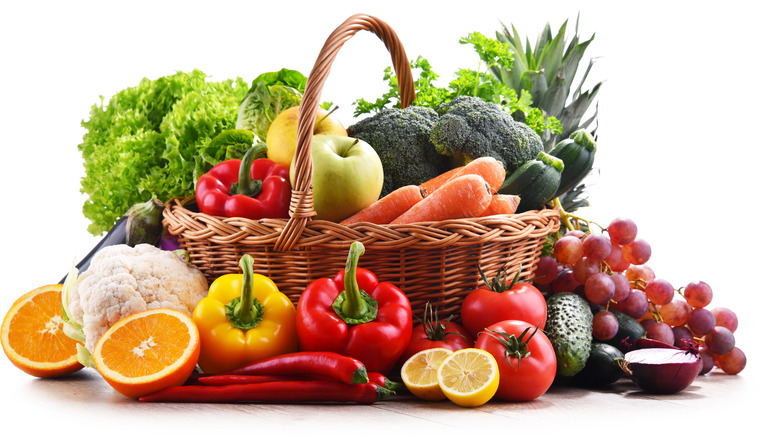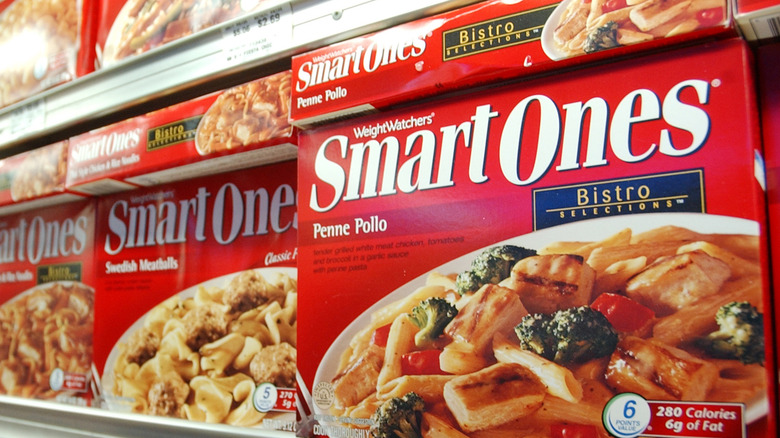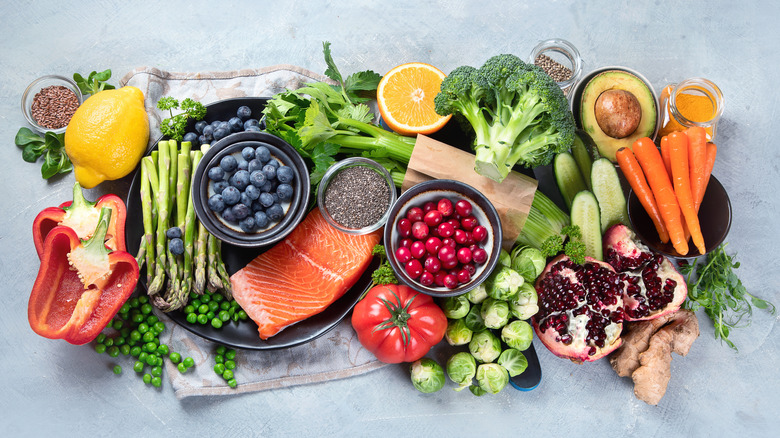The Truth About Lean Cuisine
There are many benefits to frozen foods: They are convenient, cost-effective, and can even help out with portion control. If you believe that frozen foods are inherently less healthy somehow, that's not exactly true. According to the Journal of Agricultural and Food Chemistry, frozen foods retain their nutrition, including vitamin, mineral, carbohydrate, protein, and fat content. In some cases, there may even be advantages to eating frozen foods. That's because vitamins and minerals in fresh foods can diminish over time.
Of course, not all frozen foods are created equal. You should keep an eye out for added sugar, sodium, and saturated fat content in your selections by carefully reading nutrition labels (per WebMD). Additionally, choose entrees with plenty of vegetables, whole grains, and lean protein. Meals including more of these ingredients are often lower in calories and higher in fiber, which can help prevent hunger.
One frozen food brand to consider is Lean Cuisine, which has been around for over 40 years. The company is known for keeping up with current health trends and consumer desires (per The Daily Meal). Plus, Taste of Home describes Lean Cuisine as one of "12 healthy frozen food brands you'll actually want to eat." However, they also suggest taking care when choosing your entrees, since some are healthier than others. Below, we discuss the truth about Lean Cuisine.
Lean Cuisine has evolved from a diet product to a lifestyle brand
Lean Cuisine was launched in 1981 by Stouffer's, one of Nestle's brands, as a weight management product (per Mental Floss). They were an instant success, tripling sales projections in the first year and quickly reaching a national distribution level. In recent years, Lean Cuisine has tried to move their focus away from weight loss. Nestle's website clarifies, "With Lean Cuisine products you won't find any fad diets or miracle cures — just solid nutritional foundation, great taste, clear information and sensible guidance from registered dieticians." These days, Lean Cuisine offers a range of newer products that follow current health trends, such as gluten-free and low-carb entrees.
But not everyone is convinced that Lean Cuisine provides health benefits. Nutritionist Laura Silver, for one, explains (via Vox) that Lean Cuisine entrees consist primarily of refined pasta and meat, along with potatoes and not enough vegetables. She also points out that 200 to 300 calories per entrée is simply not adequate for a meal. Additionally, the article critiques Lean Cuisine's contributions to an unhealthy diet culture. Even their recent marketing efforts focused on maintaining better health over losing weight haven't entirely changed things: "Lean Cuisine talking less about weight loss doesn't mean that Lean Cuisine is talked about any less by people who care about weight loss. A product is a product. It doesn't matter what you say about it if that doesn't actually change what ends it's used for."
The brand offers dozens of products
One great thing about Lean Cuisine is how many different product options are available. The brand offers a wide range of frozen entrees, bowls, pastas, pizzas, and sandwiches. Their items can also meet different dietary preferences including gluten-free, carb-conscious, high-protein, meatless, and low calorie. In other words, no matter your dietary approach, you are likely to find some options that also suit your taste palate.
To help narrow things down, Best Diet Tips gathered information from online reviews, blogs, and comments to determine the best tasting Lean Cuisine entrees. Their results suggest that you may want to try the Spinach, Artichoke, & Chicken Panini, Ranchero Braised Beef, Tortilla Crusted Fish, and Butternut Squash Ravioli. But you should also keep in mind which entrees are best nutritionally. A helpful article in Yahoo News! ranked Lean Cuisine entrees based on their content of protein, fiber, and good-for-you fats. Some of their top picks include Salisbury Steak with Macaroni & Cheese, Glazed Chicken, Chicken Ranch Club Flatbread Melt, and (surprise!) Deep Dish Three Meat Pizza.
Lean Cuisine meals are low in calories
As you probably already know, restricting caloric intake can help you lose weight: "Despite all the diet strategies out there, weight management still comes down to the calories you take in versus those you burn off" (per WebMD). Of course, keep in mind that calories aren't inherently a bad thing. Calories provide energy, which your body needs to function properly. But when you eat more calories than you burn, they are stored within the body as fat.
To lose an estimated 1 pound per week, you should aim to trim 500 to 1,000 calories a day from your normal diet. Sounds simple enough, right? Unfortunately, many of us know that changing the way we eat isn't exactly easy. To get started, WebMD recommends avoiding high-calorie items with low nutrition, selecting low-calorie foods over high-calorie ones, and reducing portion sizes.
Eating pre-proportioned meals like those created by Lean Cuisine can be a helpful tool towards reducing your overall caloric intake. However, keep in mind that some experts believe that Lean Cuisine products may be too low in calories and other nutrients, involving empty chemicals instead of real food. "Although the mouth-watering images plastered on their boxes give the appearance that each package contains a nutrient-dense meal, some containers provide fewer calories and macronutrients than a granola bar," states Eat This, Not That! If you decide to eat Lean Cuisine entrees regularly, make sure that you are eating them as part of a nutritionally based plan.
Lean Cuisine products are low in fat
Did you know that the "lean" in Lean Cuisine is more than a marketing ploy? In fact, this term is considered a nutritional claim by the US Food and Drug Administration (FDA), according to Eat This, Not That! This means that all Lean Cuisine products are required to adhere to FDA regulatory guidelines for fat, saturated fat, and cholesterol levels. In other words, Lean Cuisine products must contain less than 10 grams of fat, 4.5 grams or less of saturated fat, and 95 mg of cholesterol per serving (per the FDA Regulatory Guidelines for Nutritional Content Claims).
So, how do these numbers align with healthy daily fat intake goals? The Cleveland Clinic suggests aiming for between 44 and 77 grams of fat per day, based on a 2,000 calorie-a-day diet. That's 20% to 35% of your total caloric intake. In terms of saturated fat, you'll want to try to keep it below 22 grams per day (7% or less of total calories).
Lean Cuisine products contain less sodium than many other frozen food brands
One potential issue with eating frozen foods involves their typically high sodium content. Healthfully explains some reasons why brands may include unhealthy amounts: To begin with, most Americans are used to eating salty foods, as salt is cheaper and easier to use than many other flavorings, spices, and herbs. Sodium can also be used as a preservative in certain foods. Unfortunately, a common response to eating lower sodium foods is that they taste bland –– and who wants to eat (or buy) bland food? That said, we want you to be aware that the American Heart Association recommends consuming no more than 2,300 mg of sodium per day. Ideally, it would be best not to exceed 1,500 mg, especially if you have high blood pressure.
The exact sodium content in Lean Cuisine products depends on which entrée you select. Many entrees fall within the 600 to 700 gram range, but there are some options containing under 500 grams –– including Comfort Glazed Chicken (470 mg) and Wood Fire-Style BBQ Recipe Chicken Pizza (380 mg), per Eat This, Not That! You may wish to avoid any frozen entrees containing over 700 mg, such as Lean Cuisine Sesame Chicken (830 mg) – Eat This, Not That! cites this particular product on their list of "the worst frozen dinners on store shelves." Of course, it isn't nearly as bad as some others mentioned, including Hungry-Man Double Chicken Bowl Boneless Fried Chicken (2,090 mg), DiGiorno Cheese Stuffed Crust Three Meat Small-Sized Pizza (1,530 mg), and Hungry-Man Selects Golden Battered Chicken with Cheese Fries (1,620 mg).
You may need to supplement protein
Another truth about Lean Cuisine is that some of their products involve low protein content. In fact, certain entrees contain as little as 6 grams of protein (per Livestrong). This is problematic because adequate protein intake is essential for your body's function, helping it to repair cells and create new ones, according to MedlinePlus. Getting enough protein is especially important for children, teens, and women who are pregnant.
Harvard Medical School explains that the recommended dietary allowance (RDA) is 0.8 grams of protein per kilogram of body weight. To calculate your own body's needs, simply multiply your weight in pounds by 0.36. You can also focus on choosing healthy protein options instead of on the exact amount consumed each day. EatingWell points to some healthy protein sources such as lean beef, salmon, chicken, and eggs. Additionally, good vegetarian sources include peanut butter and lentils.
Note that on Lean Cuisine's website, you can sort products by their protein content. High protein entrees include the Chicken Club Panini (24 g), Glazed Chicken (24 g), and Sesame Stir Fry with Chicken (25 g). If you prefer Lean Cuisine's lower protein items, we recommend supplementing your meal with a healthy protein source.
Lean Cuisine products tend to be low in fiber
Getting enough fiber in your diet is important for your health. Along with its ability to prevent constipation, fiber can also help you lose weight and manage high blood sugar levels (per Healthline). Women should aim for about 24 grams of fiber each day; men, 38 grams. Unfortunately, most Americans average closer to 16 grams, with an estimated 95% of the population failing to meet the recommended daily fiber goal.
You may be wondering, can eating Lean Cuisine products help? While fiber content varies by product, many Lean Cuisine entrees contain only 2 or 3 grams of fiber. However, Food Processing reports that the Lean Cuisine Spa Cuisine entrees have bumped up fiber content to 5 or 6 grams, which equates to about 20% of your daily recommended amount. This product line consists of 16 entrees, including Apple Cranberry Chicken, Roasted Honey Chicken, and Thai-Style Noodles with Chicken.
Of course, even 5 to 6 grams of fiber doesn't set you up well to reach the daily recommendation. Therefore, it may be beneficial to supplement your Lean Cuisine entrée with additional fiber sources. WebMD suggests beans, peas, artichokes, barley, raspberries, blackberries, and prunes as top fiber sources. Other good sources include fresh fruits, vegetables, and whole grains — particularly dark leafy greens, sweet potatoes, carrots, potatoes with skin, oats, popcorn, strawberries, blueberries, and apples.
Lean Cuisine meals may help lower cholesterol levels
High cholesterol levels in the body can be dangerous, leading to plaque buildup in the arteries. This condition can impede circulation and increase your risk for heart attack and stroke (per the Mayo Clinic). While some risk factors (i.e. genetics and aging) for high cholesterol are out of your control, lifestyle can also play a role. Improving your diet, losing excess weight, getting more exercise, limiting alcohol, and quitting smoking are all ways to lower your cholesterol levels and reduce your risk of developing serious complications.
WebMD explains the connection between excess body weight and high cholesterol: When you are overweight, you are more likely to have high levels of low-density lipoprotein (LDL) in your blood. Excess LDL, sometimes known as "bad cholesterol," increases your risk of developing heart problems and other serious health conditions. For every 10 extra pounds you carry around in bodyweight, your body can produce an additional 10 milligrams cholesterol each day.
If you're aiming to lose weight, eating Lean Cuisine products is one easy way to track calories and manage portion sizes (per Livestrong) –– but to determine the best weight loss plan for your individual situation, we encourage you to talk to your doctor.
These products may help you manage diabetes
If you have diabetes or are at risk for developing it, following a healthy lifestyle can help. Risk factors for diabetes include being overweight, over the age of 45, and leading a sedentary lifestyle, according to the Centers for Disease Control and Prevention (CDC). You are also considered at increased risk if you have prediabetes, a family history of diabetes, or have experienced gestational diabetes in the past.
To best manage your condition, the National Institute of Diabetes and Digestive and Kidney Diseases suggests learning all you can about diabetes, eating a healthy diet, getting plenty of physical activity, and working closely with your healthcare team. In terms of diet, you'll want to reach for healthy carbohydrates (fruits, vegetables, whole grains, legumes, and low fat dairy products), fiber-rich foods, heart-healthy fish, and some healthy fats (avocado, nuts, and olive and canola oils). It is also a good idea to avoid saturated and trans fats, cholesterol, and sodium (per the Mayo Clinic).
You may want to ask your doctor or dietician if Lean Cuisine entrees can be part of your diabetes management plan. Of particular note is that Lean Cuisine now offers Cauli-bowls, which have replaced refined pasta with pasta made from cauliflower, arrowroot powder, tapioca starch, eggs, and konjac flour, according to Baking Business. There are six Cauli-bowl varieties available, including Creamy Mac & Cheese, Fettuccine with Meat Sauce, and Garlic Parmesan Alfredo with Broccoli.
Lean Cuisine products provide healthier alternatives to traditional comfort foods
If you crave comfort foods like macaroni and cheese, pizza, and pasta dishes, Lean Cuisine has you covered with generally fewer calories, less fat, and lower amounts of sodium and cholesterol. Psychology Today explains some of the many reasons why we crave comfort foods: They make us feel good (temporarily) by triggering the brain's "reward system," can be used to self-medicate, and tend to give us a sense of belonging or nostalgia that is reminiscent of past gatherings and fond childhood memories. Comfort foods can also signal special occasions.
For some individuals, choosing Lean Cuisine versions of their favorite comfort foods can help them lose weight and stick to a healthier eating plan overall. For others, eating any comfort foods at all may lead to more problems. According to Verywell Fit, indulging in comfort foods (such as meatloaf, mashed potatoes, lasagna, or macaroni and cheese) can result in more cravings for these typically high-fat items. These foods often contain a lot of carbohydrates and sodium, with little nutrition, and may even cause you to eat more.
Lean Cuisine offers organic, meatless options
Vegetarians, rejoice! While you've probably noticed that Lean Cuisine offers an awful lot of chicken dishes, they have also introduced an Origins product line that includes 14 meatless options made with at least 70% organic ingredients. And, according to a 2019 press release by Nestle USA, Lean Cuisine Origins was even named a Product of the Year in the frozen entrée category.
Food Processing also appears to be a big fan of Lean Cuisine Origins products, stating: "Each features on-trend ingredients in innovative ways, putting a new, flavorful twist on plant-based proteins and vegetables and playing at the intersection of a desire for meatless options and an increasing demand for organic foods." Entrée options include Butternut Squash Lasagna, Linguine with Ricotta and Spinach Meatless Meatballs, and Mushroom and Vegetable Shepherd's Pie.
There are even a couple of vegan-friendly options: Lean Cuisine Origins Coconut Chickpea Curry and Lean Cuisine Sicilian-Style Pesto with Lentil Pasta. The company's marketing director, Julie Lehman, told VegNews, "The new Origins subline offers even more of what our consumers are after, from gluten-free foods to meatless offerings to options made with organic ingredients and, now, vegan dishes."
Lean Cuisine has strong competitors
Although Lean Cuisine was one of the first healthy frozen food brands to the market, they now have some strong competition. You have likely noticed major brands like Healthy Choice and Smart Ones alongside Lean Cuisine in the freezer section. WebMD also points out some healthy frozen meals from Michelina's, Trader Joe's, Seeds of Change, and Amy's, and Taste of Home praises a number of additional frozen food brands such as EVOL, Kashi, and Saffron Road.
In other words, you definitely have a lot of options when it comes to choosing a healthy frozen meal these days. No matter which brand(s) you ultimately decide to stock in your at-home freezer, be sure to consider the nutrition labels along with your personal taste preferences. To this end, the FDA provides a thorough explanation on how to understand nutrition labels, including a product's serving information, calories, and nutrients.
Some women are pushing back against Lean Cuisine's marketing messages
A 2018 marketing campaign by Lean Cuisine asked women to define what having "it all” would involve. Although intended to showcase women's empowerment, many women were instead offended by the insinuation that they still needed to aim for such an unrealistic goal (per Insider).
Faux Feminism further breaks down how Lean Cuisine got "it all wrong" with their messaging: "The issue is real — anybody balancing work/life knows it's a challenge — but the REAL problem is that this concept of 'having it all' is inherently sexist and deeply misogynistic." They continue on to state that men are rarely asked how they balance home versus work life, whereas women often take on the bulk of family and home responsibilities.
Julie Lehman, marketing director for Lean Cuisine, defended the campaign to The Washington Post, saying, "There's so much negativity around the female relationship when it's a source of great strength. [The campaign] allows you to really understand your own 'it all' in your own way."
Lean Cuisine products should not be the only thing you eat
The truth about Lean Cuisine products is that they can be a part of a healthy diet plan, but they should not be the only thing that you eat. Eat This, Not That! describes some potential pitfalls that can happen to your body when you eat frozen dinners. For instance, you may have incomplete nutritional intake, become bloated, feel thirsty, and increase your risk of developing type 2 diabetes. On the plus side, you will probably eat fewer calories per meal, which can help you lose or maintain your weight.
To best fit Lean Cuisine and other frozen entrees into your weight loss plan and overall diet, Verywell Fit suggests using them sparingly as part of a complete meal plan. Your plan should also include fresh fruits and vegetables, whole grains, and home-cooked meals in order to establish healthy food preparation habits. To balance out Lean Cuisine's high sodium content, you may also need to cut back on sodium during other meals and snacks. Finally, make sure to read the nutrition labels to see what might be lacking (i.e. vegetables, protein, and fiber); then, supplement with additional foods as appropriate.

